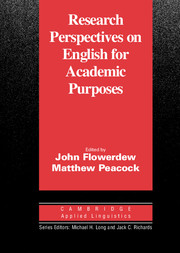Book contents
- Frontmatter
- Contents
- List of contributors
- Series editors' preface
- Preface
- I ISSUES IN ENGLISH FOR ACADEMIC PURPOSES
- Introduction to Part I
- 1 Issues in EAP: A preliminary perspective
- 2 Language use, language planning and EAP
- 3 EAP-related linguistic research: An intellectual history
- 4 Linguistic research and EAP pedagogy
- 5 International scientific English: The language of research scientists around the world
- 6 Discipline specificity and EAP
- 7 World Englishes: Issues in and from academic writing assessment
- 8 Addressing issues of power and difference in ESL academic writing
- 9 ‘I'll go with the group’: Rethinking ‘discourse community’ in EAP
- 10 EAP assessment: Issues, models, and outcomes
- II THE ENGLISH FOR ACADEMIC PURPOSES CURRICULUM
- References
- Index
10 - EAP assessment: Issues, models, and outcomes
Published online by Cambridge University Press: 05 October 2012
- Frontmatter
- Contents
- List of contributors
- Series editors' preface
- Preface
- I ISSUES IN ENGLISH FOR ACADEMIC PURPOSES
- Introduction to Part I
- 1 Issues in EAP: A preliminary perspective
- 2 Language use, language planning and EAP
- 3 EAP-related linguistic research: An intellectual history
- 4 Linguistic research and EAP pedagogy
- 5 International scientific English: The language of research scientists around the world
- 6 Discipline specificity and EAP
- 7 World Englishes: Issues in and from academic writing assessment
- 8 Addressing issues of power and difference in ESL academic writing
- 9 ‘I'll go with the group’: Rethinking ‘discourse community’ in EAP
- 10 EAP assessment: Issues, models, and outcomes
- II THE ENGLISH FOR ACADEMIC PURPOSES CURRICULUM
- References
- Index
Summary
Introduction
The aim of this chapter is to provide an overview of issues in EAP assessment, with a particular focus on various ways in which information on student proficiency and achievement in EAP programmes is gathered for purposes of selection, curriculum monitoring and programme accountability. The first part of the chapter outlines the purposes for which assessment takes place in EAP contexts and examines issues surrounding the use of English language proficiency test scores as criteria for university admission. In this context, current debates concerning the validity and reliability of EAP tests are discussed. Methods of assessing course-related achievement in EAP programmes are then briefly canvassed, with particular reference to portfolio assessment. The second part of the chapter looks at the question of outcome measurement in EAP programmes. Following a survey of different approaches to measurement of language gains, we describe an empirical study of gains made over time by learners in an EAP listening programme in Japan. The results of the study suggest that if instruction is carefully targeted, achievement of specific course objectives will be reflected in gains in general academic listening proficiency.
Assessment in EAP programmes
Assessment in EAP programmes is carried out for a variety of purposes which can be roughly categorised under the general headings of achievement assessment and proficiency assessment. To provide a framework for the discussion that follows, these terms will be briefly defined and exemplified.
- Type
- Chapter
- Information
- Research Perspectives on English for Academic Purposes , pp. 148 - 166Publisher: Cambridge University PressPrint publication year: 2001
- 3
- Cited by

